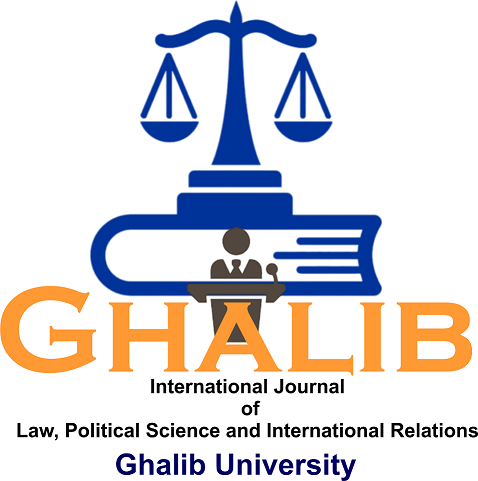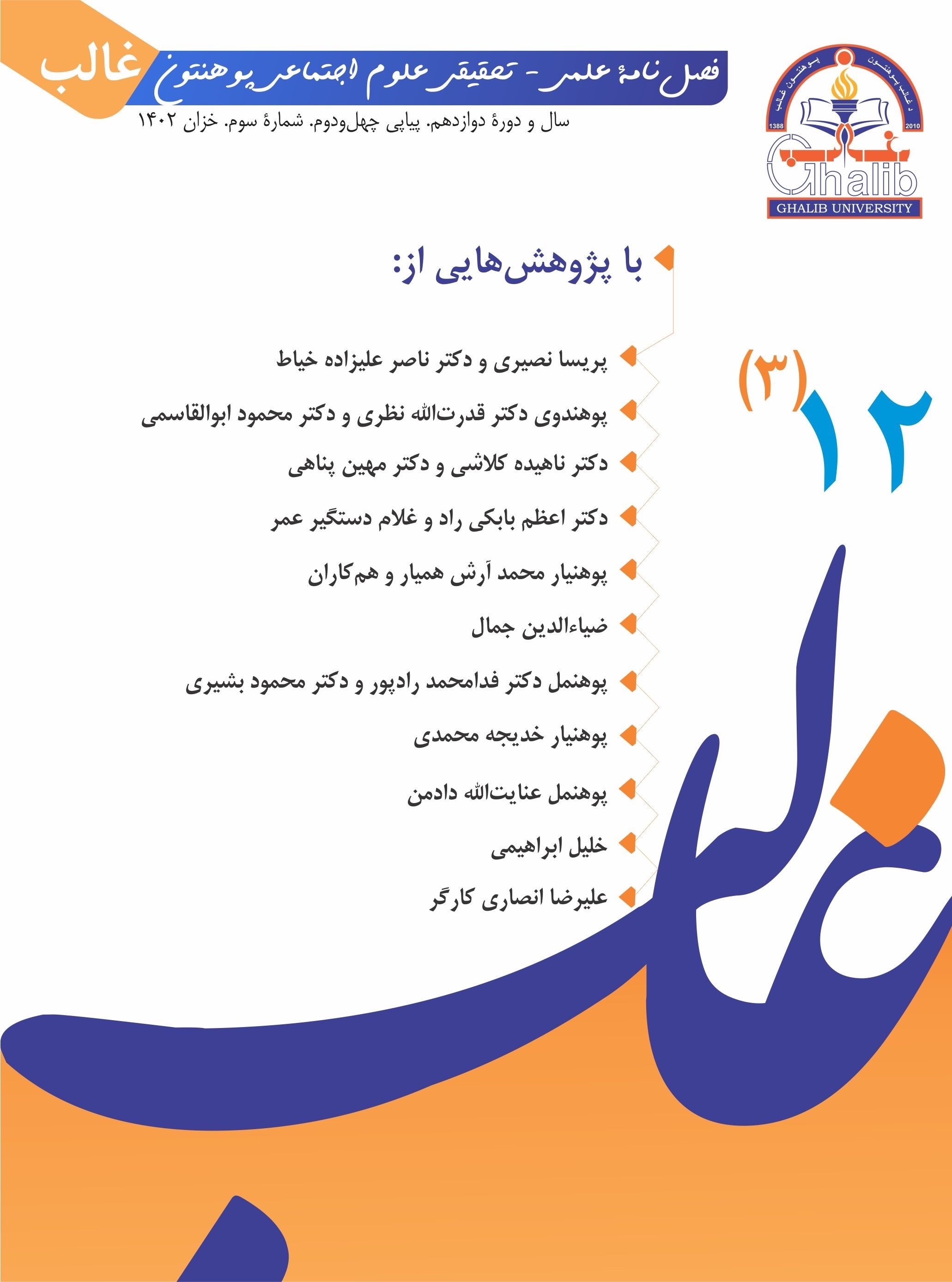تأثيرات اقتصادی خسارات ساختمانی سيلاب سال ۱۳۹۹ شهر چاريکار
DOI:
https://doi.org/10.58342/ghalibqj.V.12.I.3.5واژهگانِ کلیدی:
خسارات ساختمانی، زيان اقتصادی خانوادهها، سيلاب، سيلابزدهگان پروان، مدل مشارکتيچکیده
افغانستان کشوریاست کوهستانی و ازسوی ديگر، عدم داشتن زيربنای اساسی، همواره دُچار سيلابهای خُرد و بزرگ بوده، که با وقوع يک سيلاب بزرگ تاريخی در شهر چاريکار ولايت پروان در سال ۱۳۹۹، متأسفانه باوجود تلفات جانی، خسارات هنگفت مالی نيز برجا گذاشته است و بیشتر ساختمانهای مناطق سيلابزدهٔ اين شهر، بهطور کامل تخريب گرديد؛ مسألهٔ مهم تحقيق اين بوده است، که اقتصاد ساکنان مناطق سيلابزده به چه ميزان متضرر ناشي از تخريبشدن خانههای شان شده است؟ و بهمنظور سنجش ميزان خسارات مالی ناشی از تخريب ساختمانها و تأثيرات آن بالای اقتصاد خانوادهها متضرران از ابزار پرسشنامهيی با استفاده از مدل کاری مشارکتی استفاده شده است؛ پرسشنامهٔ طراحیشده به جامعهٔ آماری تحقيقی که شامل ۲۰۱ نمونهیی بوده با استفاده از روش نمونهگيری سهميهیی در تطابق به مدل فوقالذکر توزيع شد، که ضريب اعتمادپذيری آن نشاندهندهٔ پايايي مناسب و مطلوب پرسشنامه را نشان ميداد، که بعد از تجزيهوتحليل پرسشنامه يافتههای تحقيق نشان میدهند که: در مجموع عموم ساختمانهای تخريبشده در شهر چاريکار به تعداد ۲۰۱ ساختمان بوده، که ارزش تخمينی قبلي آنها معادل به ۸۶۵۹۹۰۰۰۰ افغاني محاسبه گرديده و ضرر وارده به آنها معادل به ۲۰۵۱۶۰۰۰۰ افغانی تخمين شده است، که متأثر شده، اقتصاد خانوادهها از اين حادثه بهمراتب از عين مبلغ متذکره بيشتر است و اين رقمی قابل ملاحظهییاست که اقتصاد خانوادهها قربانی ناشی از تخريبات ساختمانهای مسکونی شان متضرر شده است.
سرچشمهها/ منابع
۱. ادارهٔ ملی آمادهگی مبارزه با حوادث افغانستان. (۲۰۱۵). «استراتژی ادارهٔ ملی آمادهگی مبارزه با حوادث در افغانستان از سال ۲۰۱۵ تا ۲۰۱۹». افغانستان: ادارهٔ ملّی آمادهگی مبارزه با حوادث افغانستان.
۲. سلیمانی، کریم و همکاران. (۱۳۹۹). «الگوریتم آشکارسازی پهنهٔ خسارت سیل با استفاده از تصاویر سنتینل 2 (مطالعه موردی: سیلاب فروردین ۱۳۹۸ استان گستان)». ایران: مجلهٔ آکوهیدرولوژی. ۷ (۲). ۳۰۲-۳۱۲.
۳. صفاری، امیر و همکاران. (۱۳۹۰). «ارزﻳﺎبی آﺳﻴﺐﭘﺬﻳﺮی ﻣﻨﺎﻃﻖ ﺷﻬﺮی در ﺑﺮاﺑﺮ ﺧﻄﺮ ﺳﻴﻞ ﺑﺎ اﺳﺘﻔﺎده از ﺳﻴﺴﺘﻢ اﻃﻼﻋﺎت ﺟﻐﺮاﻓﻴﺎیی و ﻣﻨﻄﻖ ﻓﺎزی (ﻣﻄﺎﻟﻌهٔ ﻣﻮردی: ﺗﻬﺮانمنطقهٔ ۳)». ایران: نشریهٔ علمی وزارت علوم. شمارهٔ ۲۰.
۴. عبداللهزاده، غلامحسین و همکاران. (۱۴۰۰). «بررسی ارزیابی آسیبپذیری خانوارها در مواجهه با خطر سیلاب در نواحی روستایی (مطالعهٔ موردی: شهرستان آققلا و گمیشان)». ایران: نشریهٔ تحلیل فضایی مخاطرات محیطی. ۸(۲). ۱۰۱-۱۱۸.
۵. عظیمی، محمد نعیم. (۱۳۹۸). روش تحقیق. افغانستان-کابل: انتشارات سعیدی.
۶. فرزانه، محمدرضا و همکاران. (۱۴۰۱). «توسعه روششناسی برآورد سیلاب مبتنی بر سنجش از دور در محیط گوگلاِرث انجین». ایران: مجلهٔ محیط زیست و توسعهٔ فرابخشی. ۷(۷۶). ۱۲-۲۶.
۷. فندرسکی، نیایش و همکاران. (۱۳۹۳). «کاهش خسارت سیلاب شهری با استفاده از مدیریت غیرسازهای (مطالعهٔ موردی: سیلاب نکا، ۱۳۷۸)». ایران: پژوهشنامهٔ مدیریت حوزهٔ آبخیز. ۵(۱۰). ۱-۱۴.
۸. رضایی، حمیدرضا؛ شکور، علی. (1388). «بررسی و نقش عوامل مشخصکنندهٔ بحران سیل در مدیریت شهری». ایران: همایش ملّی مدیریت بحران آب. https://sid.ir/paper/811039/fa>.
۹. مصفا، نسری؛ پاشابنیاد، موسی. (۱۳۹۶). «وظایف و اختیارات متقابل دولت آسیبدیده و سازمانهای بینالمللی در امداد رسانی حوادث طبیعی». ایران: فصلنامهٔ مطالعات حقوقی عمومی ۴۷ (۳). ۶۴۷-۶۶۴.
۱۰. مقدم، حسن حسنی؛ تراهی، علی اصغری. (۱۳۹۸). «مقدم به بررسی تعیین گسترهٔ سیل با استفاده از دادههای سنجندهٔ OLI (مطالعهٔ موردی: سیل سال ۱۳۹۵ دزفول)» ایران: مجلهٔ محیط زیست و مهندسی آب. ۵ (۱). ۲۴-۳۵.
۱۱. وازارت مبارزه با حوادث طبیعی. ۱۳۹۹.
۱۲. وزارت مبارزه با حوادث افغانستان. (۱۳۹۹). گزارش ریاست ضد حوادث ولایت پروان در خصوص معلومات تعدا کشتهشده و زخمیشدهها».
References
Afghanistan's National Disaster Management Authority. (2015). “The strategy of the National Disaster Management Authority in Afghanistan from 2015 to 2019”. Afghanistan: Afghanistan's National Disaster Management Authority.0020. (Persian)
Abdullahzadeh, Gulam Muhsin and et al. (1400). “Investigating the vulnerability assessment of households regarding flood risk in rural areas (Study: Aqqola and Gamishan cities)”. Iran: Journal of environmental risk analysis, 8(2). 101-118. (Persian)
Afghanistan Ministry of Disaster Management (ANDMA). (2019). “The anti-accident directorate of Parwan province (2019) has been killed and injured in private information”. Afghanistan-Parwan. (Persian)
Azimi, Mohammad Naeem. (1398). “Methodology”. Afghanistan: Publisher Saeedi.
Farzaneh, Mohamad Raza et al. (1401). “Development of flood assessment methodology based on remote sensing in Google Earth Engine environment”. Iran: Journal of Environment and Transsectoral Development, 7(76). 12-26. (Persian)
Fendersky, Neyesh and et al. (2013). “Reduction of urban flood using non-structural management (case study: Neka flood, 2008)”. Watershed Management Journal, 5(10). 1-14. (Persian)
Mosfa, Nasrin; and Pashabaniad, Mousa. (1388). “Investigation and role of flood crisis determinants in urban management of Tehran”. Iran: Tehran Azad University.
Mosfa, Nasrin; and Pashabaniyad, Mousa. (2016). “The role and mutual powers of the affected government and international organizations in natural disaster relief”. Iran: General Legal Studies Quarterly, 47(3), 647-664. (Persian)
Moqadam, Hasan Hasani; and Tarahi, Ali Asgher. (2018). “Introduction to the study of flood extent determination using OLI sensor data (case study: Dezful flood of 2015)”. Iran: Journal of Environment and Water Engineering, 5(1). 24-35. (Persian)
Ministry of Combating Natural Disasters. (2019). Afghanistan. (Persian)
Soleimani, Karim and el al. (2019). “Algorithm for forecasting the flood zone using Sentinel 2 images (Study: Floods of Gostan province 2018)”. Iran: Aquahydrology, 7(2), 312-302. (Persian)
Safari, Amiri and et al. (1390). Afghanistan: Journal of the Ministry of Science (20). (Persian)
چاپ شده
ارجاع به مقاله
شماره
نوع مقاله
مجوز
حق نشر 2023 فصلنامۀ علمی - پژوهشی غالب

این پروژه تحت مجوز بین المللی Creative Commons Attribution 4.0 می باشد.













